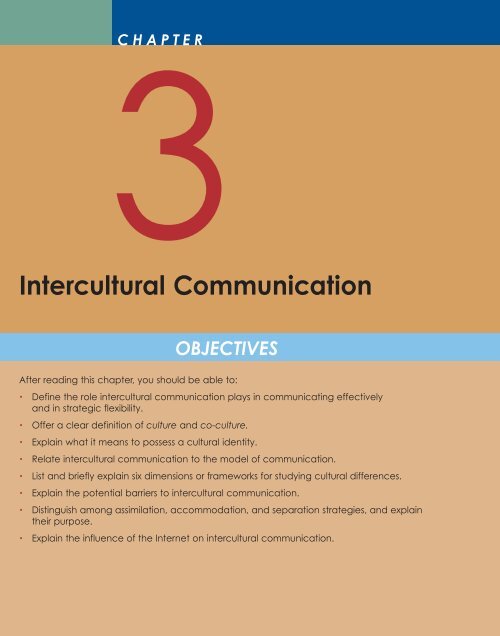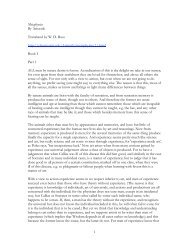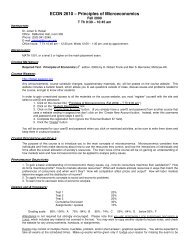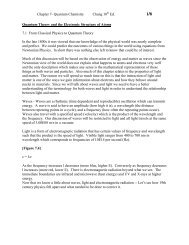Intercultural Communication - PageOut
Intercultural Communication - PageOut
Intercultural Communication - PageOut
You also want an ePaper? Increase the reach of your titles
YUMPU automatically turns print PDFs into web optimized ePapers that Google loves.
CHAPTER<br />
3<br />
<strong>Intercultural</strong> <strong>Communication</strong><br />
OBJECTIVES<br />
After reading this chapter, you should be able to:<br />
• Define the role intercultural communication plays in communicating effectively<br />
and in strategic flexibility.<br />
• Offer a clear definition of culture and co-culture.<br />
• Explain what it means to possess a cultural identity.<br />
• Relate intercultural communication to the model of communication.<br />
• List and briefly explain six dimensions or frameworks for studying cultural differences.<br />
• Explain the potential barriers to intercultural communication.<br />
• Distinguish among assimilation, accommodation, and separation strategies, and explain<br />
their purpose.<br />
• Explain the influence of the Internet on intercultural communication.
56 Part 1 Basic Principles of <strong>Communication</strong>s<br />
MY NAME IS STANLEY MARTINEZ, AND I WAS INTRODUCED TO GANGS,<br />
drugs, and violence at an early age. My uncle, a burly man covered<br />
in tattoos who was just released from the state penitentiary,<br />
taught me the rules of our neighborhood, and those rules, along<br />
with drugs and alcohol, served as my school of survival. I grew up<br />
fast, and the inner strength gained from my uncle’s advice, my ability to watch<br />
and listen, and my common sense caused the home boys I ran with to make me<br />
their gang leader. Their trust in me not only gave me courage and comfort but<br />
it also empowered me. They also broadened my perspective.<br />
All through my life it was as if I were outside myself looking in, and when I lost<br />
gang members because of useless deaths on the street, addictions to drugs,<br />
and unwanted pregnancies, I realized I had a higher purpose. A member of the<br />
Chicano Youth Center (CYC) helped me secure a job, and my employer put me<br />
in contact with the Educational Opportunity Program (EOP) which helped me<br />
enroll in college. In ethnic studies classes I learned of my heritage, and I didn’t<br />
just begin to appreciate my culture, I began to proudly share it with others.<br />
For my first speech in my speech communication class, I dressed as a gang<br />
member and talked about my life story. Halfway through the speech I took off<br />
a layer of clothing to reveal a shirt and tie, and I talked about the biases and<br />
prejudices of mainstream society that push down members of our ethnic cultures.<br />
It was in my speech communication class that I made a commitment to dedicate<br />
my life to breaking down the barriers that prevent home boys and home girls<br />
from entering college.<br />
In this chapter we first look at the role of intercultural communication in<br />
communicating effectively and in strategic flexibility. Then we look at the word<br />
culture and the importance of understanding your role as a cultural being. In the<br />
next section, we discuss the importance of intercultural communication. Then<br />
we relate this topic to the model of communication discussed in Chapter 1.<br />
We present six dimensions or frameworks for studying cultural differences. There<br />
are four barriers to intercultural communication, and we examine how to deal<br />
with the barriers—which includes a discussion of dominant and nondominant<br />
cultures. We look at ways for improving intercultural communication, and, finally,<br />
we discuss the influence of the Internet.<br />
•THE ROLE OF INTERCULTURAL<br />
COMMUNICATION IN COMMUNICATING<br />
EFFECTIVELY AND STRATEGIC FLEXIBILITY<br />
In Communicating Effectively<br />
What does intercultural communication have to do with communicating effectively<br />
First, we must all agree that it is communication skills—both sending and receiving abilities—that<br />
determine how well individuals, organizations, industries, and nations do in<br />
both acquiring and applying knowledge. The better the communication, the greater likelihood<br />
of success. Second, we must all agree that because of globalization and the importance<br />
of information, there is a rising new category in the world known as the knowledge<br />
class. It is a class supported solely by its participation in the new information industries<br />
with little, if any, reliance upon traditional manufacturing, production, or agriculture. The
Chapter 3 <strong>Intercultural</strong> <strong>Communication</strong> 57<br />
ability of members of this knowledge class to effectively negotiate the inherent cultural<br />
issues in communication will give them a competitive edge in a global world.<br />
Closer to where you live, perhaps, the relevance of intercultural communication<br />
is no less important. What if it were your job to coordinate international student<br />
services and exchange programs on your college campus What if you were the manager<br />
in a biotech company, responsible for leading a diverse team of scientists doing<br />
innovative research<br />
The world today is characterized by an ever-growing number of communications<br />
between people with different linguistic and cultural backgrounds. It is likely that you<br />
will make such contacts because they occur in the areas of business, military cooperation,<br />
science, education, mass media, entertainment, and tourism, and because of immigration<br />
brought about by labor shortages and political conflicts—as well as informally<br />
in Internet chat rooms and on Internet bulletin boards. Just a quick example will make<br />
this point. The U.S. Department of Education found that close to 40 percent of public<br />
school students were minorities in 2000, up from close to 30 percent in 1986. Also,<br />
the number of students who spoke a language other than English at home rose by 46<br />
percent from 1979 to 1999. Many teachers are faced with teaching a diverse student<br />
population. 1 The communication throughout all these contacts needs to be as constructive<br />
as possible if misunderstandings and breakdowns are to be avoided.<br />
In Strategic Flexibility<br />
<strong>Intercultural</strong> communication has a direct and noticeable effect on each step of strategic<br />
flexibility. In the first step (anticipate), you will have a new slant or angle from which<br />
to think about potential communication situations. The needs and requirements will be<br />
different than without this new knowledge, and forecasting may require the introduction<br />
of new or different skills and abilities.<br />
In the second step (assess), the factors, elements, and conditions of situations in<br />
which you find yourself will be different. Becoming alert to the introduction of these<br />
new ingredients will become easier as your experience broadens. In the third step (evaluate),<br />
you will more accurately be able to determine the value and worth of the factors,<br />
elements, and conditions and how they bear on your own skills and abilities. Because<br />
you will have developed more skills and abilities, in the fourth step (select) you will<br />
find it easier to select those most likely to affect the situation.<br />
In the fifth step (apply), you will take greater care and concern and give greater attention<br />
to the factors that are likely to be affected. You will understand how to judge their<br />
relevance with greater accuracy, and when you reassess and reevaluate your actions you<br />
will have increased sensitivity to the intercultural demands of communication situations<br />
and how you can enhance, nourish, and encourage further communication efforts.<br />
•WHAT IS CULTURE<br />
Culture is not a box but a fluid concept that is an ever-changing, living part of you,<br />
reflecting your learned, socially acquired traditions and lifestyles. The following is a<br />
useful definition. As you read it, recognize that there are no hard edges; rather, there<br />
are phenomena that tend to overlap and mingle. Culture is:<br />
The ever-changing values, traditions, social and political relationships, and worldview<br />
created and shared by a group of people bound together by a combination of factors
58 Part 1 Basic Principles of <strong>Communication</strong>s<br />
(which can include a common history, geographic location,<br />
language, social class, and/or religion). 2<br />
The word worldview means an all encompassing<br />
set of moral, ethical, and philosophical principles and<br />
beliefs that govern the way people live their lives and<br />
interact with others. Your worldview governs the way<br />
you think, feel, and behave whether you realize it or not<br />
and affects in a major way how you view every aspect of<br />
life—physical, spiritual, emotional, moral, sociological,<br />
and mental.<br />
Culture is significant in your life because it is part<br />
of you. It includes your patterned, repetitive ways of<br />
thinking, feeling, and acting. 3 Thus, it is not only maintained<br />
but often expressed through your communication.<br />
When Jonathan left a prominent position at a<br />
prestigious company, his best friend, Adam, explained<br />
his departure this way: “Voicing concern and choked<br />
with emotion, Jonathan was no longer able to step up<br />
his efforts, as his American dream turned into a nightmare,<br />
his emotional roller coaster came to a full stop.<br />
Sending shock waves through family and friends, he<br />
said his final good-byes, and called it quits.” Not only<br />
was Adam’s communication full of cliches, but each<br />
one—eight in two sentences—was uniquely American.<br />
Where do the words you choose come from They<br />
reflect your culture because that is where you learned<br />
them, that is where they originated, and they are likely<br />
to be all you know!<br />
The words you choose reflect your culture<br />
Because it is part of you, culture not only influences<br />
because that is where you learned them,<br />
your perception of your self and your perception of others<br />
(discussed in the last chapter) but your perception of<br />
and that is where they originated.<br />
everything in life with which you have contact. Think<br />
about what might be considered true American values<br />
and freedom: things like democracy, individualism,<br />
property, equality, freedom, community, and justice. The degree to which you accept<br />
these as your own values is also the degree to which you measure your sense of self on<br />
those same values. For example, you would feel better about yourself if you were actively<br />
involved in your democracy (being informed of the positions of political candidates and<br />
voting), expressing your individualism (being assertive and sticking up for your rights),<br />
and owning property (having a nice car).<br />
•YOU ARE A CULTURAL BEING<br />
One desired outcome from reading about culture is that you will recognize and accept<br />
yourself as a cultural being. Cultural identity, composed of ethnicity, culture, gender,<br />
age, life stage, beliefs, values, and assumptions, is the degree to which you identify<br />
with your culture, and it is determined by the values you support. If you were born<br />
and raised in the United States, your cultural identity involves the degree to which<br />
you identify with being American. But, it doesn’t stop there. You have a number of
Chapter 3 <strong>Intercultural</strong> <strong>Communication</strong> 59<br />
cultural identities—being a member of the student body, a particular race, a specific<br />
age group, a religion, and so on. The word co-culture represents nonwhites, women,<br />
people with disabilities, homosexuals, and those in the lower social classes who have<br />
specific patterns of behavior that set them off from other groups within a culture. 4<br />
Which cultural identity is prominent depends on the situation, the people you are with,<br />
and the conversational topics.<br />
Stanley Martinez in our earlier example was clearly a member of a gang co-culture.<br />
Although that co-culture was distinguished by members who followed the rules of the<br />
neighborhood and were often characterized by the use of drugs, alcohol, and violence,<br />
he was a member of two other cultures as well. First, he was a Latino American, a large<br />
co-cultural group where he lived. He grew up speaking Spanish, living in overcrowded<br />
conditions, and suffering extreme social discrimination—having been called lazy, shiftless,<br />
lawless, and violent, all unfortunate, negative stereotypes that had a direct effect<br />
on his self-concept. Second, he identified with being an American. Born and raised<br />
in the United States, his cultural identity involved a very clear identification with the<br />
beliefs, values, and assumptions of the dominant culture. The co-cultures of Martinez<br />
and their relationship to the dominant culture are depicted in Figure 3-1.<br />
There are three things that you need to understand about possessing a cultural identity.<br />
First, cultural identities are learned. You learn the ways of thinking, acting, and<br />
feeling from your family first, then from your friends and communities. Second, cultural<br />
identities vary in strength. Morgan, for example, had all the speech and language patterns,<br />
all the actions and reactions of a typical American student. All were so deeply<br />
embedded within her that she wasn’t even aware of it until she visited Australia with<br />
her debate team.<br />
Third, cultural identities vary in their content. For example, not everyone would<br />
define what it means to be an American in the same way, just as students have different<br />
ways of defining what it means to be a student. The importance of this point<br />
becomes evident when you begin to generalize about cultures. To what extent do you<br />
value freedom, pleasure, social recognition, and independence. These are values often<br />
<br />
<br />
<br />
<br />
<br />
<br />
Figure 3-1<br />
Relationship<br />
of Co-cultures<br />
to Dominant<br />
Culture
60 Part 1 Basic Principles of <strong>Communication</strong>s<br />
ascribed to members of the U.S. culture. What if you were a Japanese American and<br />
you held cultural identities for both these cultures The Japanese culture values selfsacrifice,<br />
harmony, and accepting traditions—values that, in part, directly contradict<br />
those of the U.S. culture.<br />
When you realize all the cultural identities people possess, you also can see the<br />
perplexities associated with the intersection of issues of race and ethnicity, language,<br />
religion, gender and sexual orientation, generation and age, and so forth, as they operate<br />
within individuals. These factors interact and come out differently in different people.<br />
Understanding cultural identities offers insights into how individuals relate to the many<br />
groups to which they belong, but not only that, to understand others, and yourself, you<br />
need to realize the variety of groups that create their (and your) cultural identity. 5<br />
Cultural identity can be a complex issue. For example, a second-generation girl,<br />
living in a minority area, whose parents are Korean immigrants, whose friends are<br />
Spanish-speaking co-workers, identifies herself as Korean American, a woman, or an<br />
American depending on the context.<br />
Cultural identity can be a simple issue, too. Some groups create their own co-cultures<br />
to isolate themselves from others. In many cities the immigrants still seem to live<br />
and work in isolation and resolve to protect their heritage by maintaining all vestiges<br />
of their culture and not assimilating. Regarding your perception of others, you might<br />
perceive them based on the same set of values—those that you hold dear.<br />
“Culture is a mental set of windows through which all of life is viewed.” 6 It is more<br />
than an environment or geographical location in which you live, and it is more than<br />
any single component of your personality or background, including your race, ethnicity,<br />
nationality, language, gender, religion, ability or disability, or socioeconomic<br />
status. These components—and certainly the way they combine and interact—affect<br />
your social and educational status as well as your family, community, and professional<br />
interactions. Culture is the way you make sense of your life. 7<br />
From this brief discussion of culture it is easier to understand intercultural communication.<br />
When a message is created by a member of one culture, and this message needs to be<br />
processed by a member of another culture, intercultural communication takes place. 8<br />
•THE IMPORTANCE OF STUDYING<br />
INTERCULTURAL COMMUNICATION<br />
The chances for contacts with people from other cultures have increased dramatically<br />
with changes in the workplace; U.S. businesses expanding into world markets<br />
in a process of globalization; people now connected—via answering machines, faxes,<br />
e-mail, electronic bulletin boards, and the Internet—to other people whom they have<br />
never met face-to-face; the ever-increasing mobility of U.S. families; and the changing<br />
demographics within the United States and changing immigration patterns as well. 9 It<br />
is precisely this increased contact that makes studying intercultural communication so<br />
important. (See Figure 3-2.)<br />
Understanding Your Own Identity. The first reason for studying intercultural communication<br />
is to develop a sensitivity to various cultural heritages and backgrounds to<br />
better understand your own identity. In her book Torn Between Two Cultures, Maryam<br />
Qudrat Aseel says, “It was through the experience of living and being raised in the<br />
United States that I came to truly appreciate and understand my own religion, heritage,<br />
culture, and language.” 10 Your decisions about the values you want to adopt or continue
Chapter 3 <strong>Intercultural</strong> <strong>Communication</strong> 61<br />
<br />
<br />
<br />
<br />
<br />
<br />
<br />
<br />
<br />
<br />
<br />
<br />
<br />
<br />
<br />
Figure 3-2<br />
The Multicultural<br />
Self<br />
The community<br />
co-culture may<br />
include work,<br />
school, friends,<br />
and romantic<br />
relationship,<br />
but these may<br />
occur outside<br />
the community<br />
as well.<br />
holding, the lifestyles or orientations you wish to pursue, and even the friends you want<br />
to have—not to mention the major, occupation, or profession you desire—are affected<br />
by racial, cultural, gender, and social-class factors that affect your personal identity, who<br />
you are and who you want to be. 11<br />
Enhancing Personal and Social Interactions. The broader your outlook, the<br />
more tolerant and accommodating you become. The chances of having close, personal,<br />
interactions with those different from you—whether in age, physical ability, gender,<br />
ethnicity, class, religion, race, or nationality—are increasing daily. Such relationships<br />
help you learn about the world, break stereotypes, and acquire new skills. 12<br />
Solving Misunderstandings, Miscommunications, and Mistrust. Until<br />
recently our nation has not learned, nor has it needed to learn, to be multiculturally<br />
competent. 13 The study of intercultural communication will not just unlock<br />
doors closed for generations; it will open those doors and, thus, resolve misunderstandings,<br />
miscommunications, and mistrust through honest, open, positive,<br />
healthy communication. People not only fear, but they also distrust the<br />
unknown. Trust is gained through knowledge and understanding.<br />
Enhancing and Enriching the Quality of Civilization. Recognizing and<br />
respecting ethnic and cultural diversity are important steps on the road to<br />
valuing the ways in which diversity enhances and enriches the quality of our<br />
civilization. According to Carlos Cortes, “many multiculturalists today seem<br />
unwilling to deal with the growing factor of intermarriage. Too much of multicultural<br />
education is frozen into a kind of group purity paradigm, when in fact,<br />
intermarriage is one of the enormous changes that is taking place in America.<br />
For example, one-third of all Latinos born in the United States now marry<br />
someone who is not Latino. . . . What will these cultural blends be like” 14 In<br />
S F<br />
STRATEGIC FLEXIBILITY<br />
Strategic flexibility requires<br />
learning about the world,<br />
breaking down stereotypes,<br />
and acquiring new skills.<br />
Greater tolerance and<br />
accommodation will expand<br />
your available skills and<br />
behaviors as you anticipate,<br />
assess, evaluate, and select<br />
from your repertoire. In<br />
addition, you will reveal greater<br />
care, concern, and attention<br />
as you apply those skills.
Working Together<br />
The word multicultural<br />
means different things<br />
to different people. The<br />
commonly held view suggests<br />
that being multicultural means<br />
being tolerant of racial and ethnic<br />
minorities, mainly of their dress, language, food, religious<br />
beliefs, and other cultural manifestations.<br />
For this activity, allow each member of your<br />
group to express his or her ideas and feelings on<br />
each of the following questions:<br />
1. Multiculturalism seeks to preserve distinctly different<br />
ethnic, racial, and cultural communities<br />
(co-cultures) without melting them into a common<br />
culture. Is this definition of U.S. society an<br />
acceptable one<br />
2. Can diversity be preserved while also establishing<br />
a unifying set of cultural symbols—symbols<br />
like language Should teachers in the United<br />
States, despite their background or current<br />
geographic location, teach students in English<br />
alone<br />
3. Should the word multicultural include—in addition<br />
to ethnic, racial, and co-cultures—struggles<br />
against sexism, heterosexism, classism, linguisism,<br />
and ableism<br />
4. Does multiculturalism encourage racial and ethnic<br />
harmony as well as cross-cultural understanding<br />
2002 there were 1,674,000 interracial marriages, close to a 40 percent increase in 22<br />
years. 15 When you consider the potential for the new perspectives, cultural insights,<br />
and unique wisdom that intermarriages can produce, there is no doubt about the corresponding<br />
increase in the quality of our civilization.<br />
Becoming Effective Citizens of Our National Communities. National communities<br />
are co-cultural groupings within the country. National communities were<br />
established from the beginning as “our forefathers acquired the lands of Native Americans,<br />
34 percent of the territory of Mexico in 1848, and the island of Puerto Rico in<br />
1898.” 16 Prior to the 1960s, most of the immigrants to the United States came from<br />
Europe, but of the million or so immigrants who now enter the United States every<br />
year, 90 percent are from Latin America and Asia. A study by the Population Reference<br />
Bureau suggests that by 2050 the United States will be a global society in which nearly<br />
half of all citizens will be from today’s racial and ethnic minorities. 17<br />
•INTERCULTURAL COMMUNICATION<br />
AND THE COMMUNICATION MODEL<br />
Using our broad definition of culture, and with the clear understanding that much of<br />
communication is intercultural, you can also see how much influence intercultural<br />
communication has had on the model of communication in Chapter 1.<br />
It Influences Senders and Receivers. If my values, traditions, social and political<br />
relationships, and worldview are different from yours, given the same subject to respond<br />
to and with everything else in the assignment the same, I will compose a significantly<br />
different response. As the differences among communicators become greater, the results<br />
in thoughts, feelings, and messages become more divergent as well.<br />
It Influences Messages and Feedback. When my parents taught in Pakistan,<br />
they were told that raising a question in the classroom is considered an affront to a<br />
respected and esteemed authority: the teacher. Instead of interpreting the lack of student<br />
response as indifference or lack of understanding, my parents encouraged students<br />
to respond among themselves with the teacher as overseer, guide, and outside resource.<br />
Jun Liu, in his book Asian Students’ Classroom <strong>Communication</strong> Patterns in U.S. Universi-<br />
62
Chapter 3 <strong>Intercultural</strong> <strong>Communication</strong> 63<br />
ties, attributes silence in Asian cultures to politeness, the pace of the discussion in U.S.<br />
classrooms, fear of wasting class time, and face saving with other international students<br />
or with the professor. 18<br />
Both verbal and nonverbal messages are affected by intercultural communication.<br />
Most Americans pay attention and show respect in the classroom by maintaining eye<br />
contact with teachers. But Navajo students in the classroom show respect by avoiding<br />
eye contact.<br />
It Influences the Setting. Setting can refer to the way communication fits into history:<br />
past, present, and future. It also describes how communication fits into a relational<br />
setting, such as the influences of power and distance, individualism versus collectivism,<br />
or femininity versus masculinity. It can refer to gender, ethnicity, or nationality.<br />
Setting, too, can relate to your own position within a speech community. If you are<br />
the only person with a physical disability in an otherwise abled environment, or the<br />
only gay man or lesbian in a heterosexual environment, you may face specific expectations<br />
or have people project their motivations on your communication. 19<br />
•STUDYING CULTURAL DIFFERENCES<br />
There are a number of ways to contrast a group of cultures to another group of cultures.<br />
20 Geert Hofstede examined cultural distinctions based on deeply rooted values<br />
and derived five dimensions. 21 A sixth dimension, Edward T. Hall’s high context versus<br />
low context, follows our discussion of Hofstede’s five dimensions. 22<br />
Cultural differences are manifest in the cultural identities of the people, as the<br />
examples within each category will reveal. Cultural identity influences behavior including<br />
choices of symbols, heroes and beroines, rituals, and even the values one chooses.<br />
The dimensions discussed here are general tendencies only. They are not always true<br />
of a culture, nor true of everyone in a culture. Jackie Low is a good example. Raised<br />
in Ohio, she has never been to China, never spoken a word of Chinese, and did not<br />
know much about China. Anyone who assumed from her looks that Jackie was Chinese<br />
would have been incorrect.<br />
Iris Chang, in her book The Chinese in America, verifies Jackie Low’s experience<br />
when she says about the ethnic Chinese in America: “None can truly get past the<br />
distinction of race or entirely shake the perception of being seen as foreigners in their<br />
own land.” 23<br />
Power Distance<br />
Power distance is a way of contrasting a group of cultures to another group of cultures<br />
by measuring social inequality in each. You will notice power differences in family<br />
customs, the relationships between students and teachers, the young and the elderly,<br />
language systems, and organizational practices. When Lennie observed Tupac—who<br />
was from Africa, a high-power-distance country—he noticed he always did as he was<br />
told by their boss, who Lennie thought was authoritarian, dictatorial, and unfair, and<br />
wasn’t afraid to say so. When he talked to Tupac, he realized most people from Africa<br />
consider their boss a benevolent dictator and do as they are told.<br />
Continents with high power distance include Africa, Latin America, and Near<br />
Eastern countries. Low-power-distance countries include the United States, Germany,<br />
China, and Great Britain.
64 Part 1 Basic Principles of <strong>Communication</strong>s<br />
Our way to contrast<br />
a group of cultures<br />
to another group<br />
of cultures is to use<br />
the dimension of<br />
power distance—<br />
social inequality.<br />
The picture reveals<br />
potential power<br />
distances between<br />
students and<br />
teacher as well<br />
as between the<br />
younger and the<br />
elderly.<br />
View “Culture and<br />
Self,” clip #9, on the<br />
CD to further understand<br />
the value of<br />
examining cultural<br />
differences.<br />
Individualism versus Collectivism<br />
The degree of integration and orientation of individuals within groups is referred to<br />
as individualism versus collectivism. When Elaine worked with the Peace Corps in<br />
Argentina, she learned about collectivist cultures. Working hand in hand with Eduardo<br />
Puerta, a native Argentinian, she realized he had never worked side-by-side with<br />
a female and needed to be in control and maintain face. In their discussions, she also<br />
came to understand his devotion to his family and preference for government control<br />
over the economy and press. Knowing about collectivist cultures helped Elaine not just<br />
understand Eduardo, but learn from and respect him as well.<br />
You will notice that people in individualistic cultures such as Great Britain, the<br />
United States, Canada, France, and Germany value self-expression, view speaking out<br />
as a way to solve problems, and use confrontational strategies to deal with interpersonal<br />
problems. In collectivist cultures such as many Arab, African, Asian, and Latin American<br />
countries, people have unquestioning loyalty to the group, and when in conflict<br />
they use avoidance, intermediaries, and other face-saving techniques.<br />
Femininity versus Masculinity<br />
A way of contrasting a group of cultures to another group of cultures that looks at the<br />
division of rules between men and women is called femininity versus masculinity.<br />
High-feminine cultures believe women should be nurturant, concerned for the quality<br />
of life, and reveal sympathy for the unfortunate. In general, feminine cultures allow<br />
cross-gender behaviors. High-masculine cultures believe men should be concerned<br />
about wealth, achievement, challenge, ambition, promotion, and that they should be<br />
assertive, competitive, tough, and recognize achievements. Masculine cultures are more<br />
likely to maintain strictly defined gender roles and, thus, have distinct expectations of<br />
male and female roles in society. High-feminine cultures include Africa and the Nordic<br />
countries of Europe. High-masculine cultures include Latin America, Great Britain,<br />
Japan, and the United States.
Chapter 3 <strong>Intercultural</strong> <strong>Communication</strong> 65<br />
Uncertainty Avoidance<br />
Uncertainty avoidance compares tolerance for the unknown when contrasting a group<br />
of cultures to another group of cultures. When Amelia entered her math classroom on<br />
the first day, she was startled to realize her teaching assistant was from Japan. Because<br />
Amelia knew Japan was a low-uncertainty-avoidance country, she was able to put into<br />
perspective much of what she learned from Junji Akimoto. Junji behaved quietly without<br />
showing aggression or strong emotions. Easy-going and relaxed, he ran an openended<br />
class.<br />
Cultures that feel threatened by ambiguous and uncertain situations and try to<br />
avoid them prefer formal rules to control social behaviors. The best example is China.<br />
Low-uncertainty-avoidance cultures need few rules and accept and encourage dissenting<br />
views and risk taking. Countries with low uncertainty avoidance include Latin<br />
America, Africa, and Japan. The United States is considered “medium” on this dimension—neither<br />
high nor low.<br />
Long-Term Orientation<br />
Long-term orientation measures the trade-off between long-term and short-term gratification<br />
of needs. This dimension was added by Hofstede as a result of his work with<br />
Michael Bond. 24 Bond labeled it Confucian dynamism. Elisha’s roommate, Mei Li,<br />
explained by example that virtuous behavior in China means acquiring skills and education,<br />
working hard, and being frugal, patient, and persevering. Knowing what long-term<br />
orientation meant helped Elisha bond with Mei Li and appreciate her industriousness.<br />
Those at one extreme on this dimension—having long-term orientation—admire<br />
persistence, ordering relationships by status, thriftiness, and having a sense of shame<br />
that emphasizes care for others and being loyal and trustworthy. China, Japan, and other<br />
Asian countries have an extraordinary long-term orientation toward life. At the other<br />
extreme—with short-term orientation—are countries like Finland, France, Germany,<br />
and the United States where people value personal steadiness and stability but do not<br />
have as much respect for tradition because it prevents innovation, nor for saving face,<br />
which can hinder the flow of business. These countries, too, favor reciprocation of<br />
greetings, favors, and gifts as related to social rituals.<br />
High Context versus Low Context<br />
High context versus low context contrasts how much information is carried in the<br />
context (high) and how much in the code or message (low). 25 In high-context communication<br />
most of the information is already in the person; very little information is<br />
in the coded, explicit, intentionally transmitted part of the message. For example, in the<br />
Japanese, African, Mexican, Asian, and Latin American cultures most of the meaning<br />
of a message is either implied by the physical setting or is presumed to be part of the<br />
individual’s beliefs, values, and norms. Often, in long-term relationships communication<br />
is high context because the slightest gesture, quickest glance, or briefest comment<br />
is interpretable without explicit statements or extended explanations.<br />
Why Because most of the information has already been experienced. Few explicit<br />
statements or extended explanations are necessary unless new areas of experience or<br />
discussion occur. Some people who date a lot tire of it simply because of the time it takes<br />
to move from low context to high context—often the preferred mode of communication<br />
because it is easier and doesn’t require as many explanations and clarifications.
66 Part 1 Basic Principles of <strong>Communication</strong>s<br />
Most Western cultures prefer low-context messages in which the majority of the<br />
information is in the communication itself—not in the context. Computer instructions<br />
are low context because they require that every space, period, letter, and number be<br />
precisely in the right location; there are no exceptions. All the information is in the<br />
instruction, or the instruction does not work.<br />
These six dimensions are basic frames of reference to help you appreciate differences.<br />
No culture is better than another; no culture is strange; no culture is unusual or foreign.<br />
Using these tools will help reduce misunderstandings by encouraging empathy, tolerance,<br />
respect, and perhaps, a more accurate interpretation of messages from people of<br />
another culture group.<br />
•BARRIERS TO INTERCULTURAL<br />
COMMUNICATION<br />
Some people do not know about other cultures, and some do not want to know. There is<br />
no doubt that both ignorance (lack of knowledge) and naivete (lack of sophistication)<br />
can be important barriers to intercultural communication.<br />
In this section, we will briefly consider ethnocentrism, stereotyping, prejudice, and<br />
discrimination. These are barriers because each is constructed around a judgment made<br />
before any communication takes place that then biases the communication that follows.<br />
All communication has a past, present, and future; barriers are part of the past that influence<br />
the communication that takes place now and affect all that follows in the future.<br />
Ethnocentrism<br />
When I lectured in Australia, I was told never to show arrogance or in any way to reveal<br />
condescension or become patronizing. It was wise advice. My hosts had warned me not to<br />
be ethnocentric: a common occurrence, they said, when Americans spoke to Australians.<br />
Ethnocentrism is the belief that one’s own cultural group’s behaviors, norms, ways<br />
of thinking, and ways of being are superior to all other cultural groups. Ethnocentrism<br />
is not to be confused with patriotism, which is devotion to one’s country. Ethnocentrism<br />
carries devotion to the extreme point where you cannot believe that another<br />
culture’s behaviors, norms, ways of thinking, and ways of being are as good or as<br />
worthy as your own. It becomes a barrier in intercultural communication when it<br />
prevents you from even trying to see another’s point of view—that is, when it hampers<br />
all attempts at empathy.<br />
Stereotyping<br />
Stereotypes are oversimplified or distorted views of another race, another ethnic group,<br />
or even another culture. They are simply ways to categorize and generalize from the<br />
overwhelming amount of information we receive daily.<br />
The problem with stereotypes is that whether they are positive or negative, once<br />
they are established, it is difficult to remove them. Sometimes they exist in our subconscious;<br />
these are even more difficult to discard because we are less aware of them.<br />
We tend to pick up information from our environment that supports the stereotypes<br />
rather than denies them. This simply embeds them more deeply. To remove them,<br />
we must first recognize them, then we must obtain individual information that will<br />
counteract them.
Consider This<br />
In her book The Majesty<br />
of the Law, Supreme<br />
Court Justice Sandra<br />
Day O’Connor discusses survival<br />
in an increasingly multinational<br />
environment:<br />
We live in a world that is constantly shrinking.<br />
Cellular phones, fax machines, beepers, e-mail—<br />
all of these new forms of communications have<br />
made it much easier for us to talk to one another,<br />
no matter where we are. We need, however,<br />
more than technology to communicate with<br />
people from other nations. We need language<br />
skills. We need deeper understanding of foreign<br />
cultures. We need to know how to survive in an<br />
increasingly multinational environment.<br />
Many of our schools recognize this need,<br />
and many parents are taking great interest in<br />
language training. High schools now offer more<br />
than French and Spanish. They are adding Japanese<br />
and Russian as well. American businesses<br />
have been in the forefront of this move toward<br />
what newspapers constantly herald as the “globalization”<br />
of trade. There are McDonald’s restaurants<br />
in Moscow, Kentucky Fried Chicken<br />
franchises in Beijing.<br />
Source: The Majesty of the Law: Reflections of a Supreme<br />
Court Justice (p. 231), by Sandra Day O’Connor, 2003; New<br />
York: Random House.<br />
Questions<br />
1. What signs have you noticed that we are now<br />
living in an increasingly multinational environment<br />
2. What implications do these changes hold for<br />
you<br />
3. If you were trying to prepare the next generation<br />
for the changes occurring in our culture, what<br />
suggestions would you make<br />
Prejudice<br />
Prejudice is a negative attitude toward a cultural group based on little or no experience.<br />
26 The difference between stereotypes and prejudice should become clear in this<br />
example: When Chris was young, his parents told him never to go into the city because<br />
Mexican gangs ruled the city streets at night. Chris, of course, then had the preconceived<br />
notion that all Mexicans were bad people. From this stereotype Chris formed<br />
a prejudice against Mexicans. The stereotype told him what a group (Mexicans) was<br />
like; the prejudice told him how to feel about the group. All this changed when Chris<br />
worked for the city to help pay his way through college, and almost all his co-workers<br />
were Mexicans. Their attitude toward Chris as well as their behavior quickly changed<br />
the stereotype and altered his prejudice.<br />
Discrimination<br />
Discrimination is the overt actions one takes to exclude, avoid, or distance oneself from<br />
other groups. 27 Discrimination takes stereotypes and prejudice one step further—to<br />
action, whether overt or covert. You can discriminate against someone subtly by slightly<br />
turning away your body when in a conversation, or by avoiding eye contact with them.<br />
You can discriminate against people by hurling verbal insults at them. You can discriminate,<br />
too, by using physical violence, systematically eliminating the group from which<br />
the individual comes, or even in extreme cases by using genocide, as when autocratic<br />
tyrants exterminate racial or national groups. Yet another form of discrimination occurs<br />
when you exclude others from jobs or from other economic opportunities.<br />
Obviously, discrimination can be interpersonal when you do it against another person,<br />
collective (when a number of individuals or a group perform the discrimination),<br />
or institutional (when a business or industry chooses not to serve a particular group<br />
of people).<br />
67
68 Part 1 Basic Principles of <strong>Communication</strong>s<br />
•DEALING WITH BARRIERS TO<br />
INTERCULTURAL COMMUNICATION<br />
For accurate communication to occur, sender-receivers must be operating from the same<br />
perceptual point of view. This is usually not a problem when we are interacting with<br />
people from our own race or culture; however, when we communicate with someone<br />
from a different race or background, we must realize that this person will be operating<br />
from an entirely different point of view.<br />
<strong>Communication</strong> between Nondominant- and<br />
Dominant-Group Members<br />
Much of the literature about communication is written from the point of view of the<br />
dominant, or majority, culture. In the United States dominant culture includes white<br />
people from a European background, while nondominant culture includes people of<br />
color; women; gays, lesbians, and bisexuals; and those whose socioeconomic background<br />
is lower than middle class.<br />
When people are not part of a dominant culture, how do they communicate with<br />
people who are In a tantalizing piece of research, Orbe looked at how people from<br />
nondominant groups (people of color; women; gays, lesbians, and bisexuals; and those<br />
from lower socioeconomic backgrounds) communicated with people from the dominant<br />
group. 28 He found that nondominant members adopted one of three basic strategies<br />
when they wanted to confront oppressive dominant structures and achieve success:<br />
assimilation, accommodation, and separation.<br />
Assimilation Strategies<br />
When nondominants use assimilation, they drop cultural differences and distinctive<br />
characteristics that would identify them with the nondominant group. As you can see<br />
in Table 3-1, there are three types of assimilation strategies.<br />
Nonassertive Assimilation. In this type of assimilation, minority members want<br />
to belong to the majority group, but they do not want to use aggression to get there.<br />
In order to achieve acceptance, they emphasize what they have in common with the<br />
Table 3-1<br />
Assimilation<br />
Nonassertive Assertive Aggressive<br />
Emphasizing what the dominant Carefully preparing for meeting Disassociating from one’s own<br />
and nondominant groups have dominant-group members group<br />
in common<br />
Acting positive Manipulating stereotypes Copying dominant-group behavior<br />
Censoring remarks that might Bargaining Avoiding interaction with other<br />
offend the dominant group<br />
co-cultural groups<br />
Avoiding controversy<br />
Ridiculing oneself
Chapter 3 <strong>Intercultural</strong> <strong>Communication</strong> 69<br />
dominant group and sometimes censor themselves to fit in. However, it often comes at<br />
a terrible cost, as you can see in the following passage:<br />
I spent the fifties essentially either going to graduate school or beginning my career<br />
as a teacher who was very much in the closet—and very much attempting to hide the<br />
fact that I was a lesbian. And that meant putting down and holding down a whole part<br />
of myself that was really vital to my being. I have these visions of faculty parties or<br />
church parties or picnics to which I would oftentimes go with a gay man friend of mine,<br />
and we would put on an incredibly good show. 29<br />
Assertive Assimilation. In assertive assimilation, people are likely to take a stronger<br />
approach to fitting in. They will often carefully prepare for an encounter with the<br />
dominant group. They may overcompensate by trying to be twice as smart, twice as<br />
witty, and so forth.<br />
African American writer Patricia Raybon, in her book My First White Friend,<br />
describes her assertive assimilation stage, which occurred when she was a child living<br />
in a predominantly white culture:<br />
I was reared to smile, to be polite, to say please and thank you and not to act ugly.<br />
I was reared to be the cleanest, nicest, smartest, kindest black child I could possibly be.<br />
That would make people like me. White people especially. 30<br />
Aggressive Assimilation. In this type of assimilation, minority-group members<br />
want to fit into the dominant group at any cost. They will imply that there are no<br />
differences between the two groups and will be careful to not do or say anything that<br />
would indicate their difference, such as speaking in a dialect or making reference to<br />
their own group’s behavior. They are so eager to be part of the dominant group that<br />
they might ridicule the group they belong to.<br />
Accommodation Strategies<br />
The next main category consists of accommodation strategies. Accommodation works<br />
toward getting the dominant group to reinvent, or at least change, the rules so that<br />
they incorporate the life experiences of the nondominant group. The three types of<br />
accommodation strategies are summarized in Table 3-2.<br />
Nonassertive Accommodation. In nonassertive accommodation, the person does<br />
not act in any way that would cause dominant-group members to be defensive or cautious<br />
but tries to make people more aware of the group she or he belongs to and tries to<br />
change stereotypes they might have. For example, Anna who is Mexican often talks to<br />
her co-workers about her friends who are professionals, trying to break the stereotype<br />
of Mexicans as manual laborers.<br />
Assertive Accommodation. Those who use this strategy try to achieve a balance<br />
between their own group and the dominant group. They try to get their own group’s<br />
members to know the dominant group by sharing something about their lives; they<br />
also attempt to educate others about their group’s members. Often they will choose a<br />
member of the dominant group as a mentor who can guide, support, and assist them.<br />
They also try to educate the dominant group about their group’s culture. Maria,<br />
for example, persuades some dominant-group members to go to a Mexican restaurant<br />
and guides them through the menu.<br />
Aggressive Accommodation. The strategy in this approach is to get into a dominant<br />
group and try to change it, although nondominant-group members may confront
70 Part 1 Basic Principles of <strong>Communication</strong>s<br />
Table 3-2<br />
Accommodation<br />
Nonassertive Assertive Aggressive<br />
Increasing visibility Letting DG members know who Confronting members of the DG<br />
they really are<br />
when they violate the rights of<br />
others<br />
Avoiding stereotypes Identifying and working with Referring to DG oppression of NG<br />
DG members who have similar<br />
goals<br />
Identifying members of the DG<br />
who can support, guide, and assist<br />
Educating others<br />
Note: DG=dominant group; NG=nondominant group.<br />
dominant-group members to gain an advantage. For example, a woman on a committee<br />
that brings international scholars to the university may point out that no women have<br />
been chosen. Persons using aggressive accommodation may also warn dominant-group<br />
members of their history of oppression.<br />
Separation Strategies<br />
In the third category of strategies, nondominant-group members have given up. In separation,<br />
nondominants do not want to form a common bond with the dominant culture,<br />
so they separate into a group that includes only members like themselves. During the<br />
1960s and 1970s, many African Americans and women, unhappy that power structures<br />
were not changing quickly enough, formed separate groups that excluded members of<br />
the dominant group as well as nondominant-group members who did not share their<br />
views (Black Muslims exclude other blacks as well as whites). Some of these groups still<br />
exist today. Table 3-3 outlines the three types of separation strategies.<br />
Nonassertive Separation. In this type of separation, the nondominant person<br />
avoids the dominant group whenever possible. Although the nondominant may work<br />
Table 3-3<br />
Separation<br />
Nonassertive Assertive Aggressive<br />
Maintaining barriers between Asserting their voice regardless of Making direct attacks on DG<br />
themselves and the DG the consequences members<br />
Keeping away from places where Making references to DG Undermining the DG by not let-<br />
DG members are found oppression with the goal of ting its members take advantage of<br />
gaining advantage<br />
their privileged position<br />
Note DG = dominant group; NG = nondominant group.
Chapter 3 <strong>Intercultural</strong> <strong>Communication</strong> 71<br />
with dominant-group members, he or she won’t go out to lunch with them or socialize<br />
after work. Through verbal and nonverbal cues, the dominant group senses that this<br />
person wants to be left alone. For example, when Tom, who is gay, is asked whether he<br />
is going to the office Christmas party, he answers no because he knows that the man<br />
he lives with would not be welcome.<br />
Some nondominant groups make no attempt to become part of the dominant group.<br />
An example is the Hmong people who immigrated to the United States because they<br />
were no longer safe in Laos. Anne Fadiman describes them after they had lived for 17<br />
years in the United States:<br />
Seventeen years later, Foua and Nao Kao use American appliances but they<br />
still speak only Hmong, celebrate only Hmong holidays, practice only Hmong religion,<br />
cook only Hmong dishes, sing only Hmong songs, play only Hmong musical instruments,<br />
tell only Hmong stories, and know far more about the current political events<br />
in Laos and Thailand than about those in the United States. . . . It would be hard to<br />
imagine anything further from the vaunted American ideal of assimilation, in which<br />
immigrants are expected to submerge their cultural differences in order to embrace a<br />
shared national identity. 31<br />
Assertive Separation. Persons practicing assertive separation work to form organizations<br />
where they can be separate from the dominant group. While in these groups, they<br />
work against any dominant-group messages that imply the dominant group is superior<br />
and they are inferior. One communication strategy they use is reminding the dominant<br />
group of their oppression. Patricia Raybon, whose passage we quoted in the assimilation<br />
discussion, describes some of the feelings that led to her assertive separation stage:<br />
White people—that relentless, heavy presence. Never benign. Never innocent.<br />
“White people” as a category embodied in my view a clear and certain evil—an arrogant<br />
malevolence—that had done unspeakable things that I couldn’t ignore because I knew the<br />
facts of these things. Names and dates and numbers. And the facts haunted me and the<br />
numbers justified my hate for all of the evil that I believed white people had done. 32<br />
Aggressive Separation. In aggressive separation, people separate from the dominant<br />
group and expect their fellow nondominant-group members to do so too. They are<br />
very critical of those who practice assimilation or accommodation. It is not uncommon<br />
for groups fighting against oppression to separate from the dominant group.<br />
If members of these groups have to have interaction with the dominant group (for<br />
example, at work), they will try to undermine the dominants by not letting them take<br />
advantage of their privileged positions. For example, an employee would bring legal<br />
action against his or her boss for discrimination.<br />
The Consequences of Nondominant- and<br />
Dominant-Group <strong>Communication</strong><br />
Orbe’s research does not lead to a very optimistic picture of American society. If we<br />
depict his results on a continuum, as in Figure 3-3, on one end are people who want to<br />
belong so much that they are willing to give up or suppress their own cultures, while on<br />
the opposite end are people who have decided that they cannot live in the dominant<br />
culture of the United States and have gone off on their own. In a country that prides<br />
itself on being a place where people from all cultures can live in harmony, nothing on<br />
the continuum is acceptable to our vision of what democracy should be.
72 Part 1 Basic Principles of <strong>Communication</strong>s<br />
Figure 3-3<br />
Nondominant<br />
Persons’<br />
<strong>Communication</strong><br />
to Dominant<br />
Groups<br />
<br />
<br />
<br />
<br />
<br />
<br />
<br />
<br />
<br />
<br />
<br />
S F<br />
S TRATEGIC FLEXIBILITY<br />
To apply the steps of strategic<br />
flexibility may require that you<br />
ask questions that help you<br />
more accurately anticipate,<br />
assess, evaluate, select, and<br />
apply your abilities and skills.<br />
Questions can also help<br />
you demonstrate the care,<br />
concern, and attention that<br />
may reveal true sensitivity—<br />
opening the doors to effective<br />
intercultural communication.<br />
•IMPROVING INTERCULTURAL<br />
COMMUNICATION<br />
Sometimes in an intercultural-communication situation with a person different from us,<br />
we may interpret the other person as abnormal, weird, or simply different. It is important<br />
to learn to control the human tendency to translate “different from me” into “less than<br />
me.” 33 Rather, we need to raise questions. Are there effective ways of dealing with different<br />
kinds of people Can I develop a repertoire of five or six approaches that<br />
will help me reach others in real and meaningful ways 34<br />
Pay attention to your words and actions. It is only through your thoughtful<br />
communication with others that you become aware of your own thinking<br />
patterns, assumptions, perceptions, prejudices, and biases. 35 When students<br />
come to Cruz-Janzen’s classes expecting to learn how to communicate with<br />
nonwhites, she tells them they are first going to study themselves, their gender,<br />
racial, ethnic, cultural, socioeconomic, and physical (ability, disability, and<br />
appearance) socialization. Cruz-Janzen has a very clear motive in this: “As long<br />
as whites continue expecting others to explain themselves, whites are setting<br />
themselves as the norm, the normal ones, against whom all others must be<br />
judged and measured.” 36<br />
Control your assumptions. An assumption is a taking for granted or supposition<br />
that something is a fact. You can learn from generalizations about other<br />
cultures, but those generalizations turn sour when you use them to stereotype<br />
or oversimplify. 37<br />
• Don’t assume that there is one right way (yours) to communicate. Question your<br />
assumptions about the “right way” to communicate.<br />
• Don’t assume that breakdowns in communication occur because others are on<br />
the wrong track. The point isn’t “who is to blame for the breakdown” it is “who<br />
can make the communication work” 38 Remember, ineffective communication<br />
can occur for a variety of reasons:<br />
• You may not have transmitted your message in a way that can be understood.<br />
• Others may misinterpret what you say. 39<br />
• Don’t assume that the preferred rules of interpersonal relationships you have<br />
learned in your culture apply universally across all cultures. They do not.
Another Point of View<br />
One popular way to<br />
educate people<br />
who will be entering<br />
another culture is to provide<br />
them with lists of do’s and<br />
taboos. The Internet, for example,<br />
is good at providing such lists. Here is what Linda<br />
Beamer and Iris Varner think of such lists:<br />
The do’s and taboos lists are usually accurate,<br />
but their helpfulness is limited: One-sentence advice<br />
on behavior is like seeing a snapshot from a movie.<br />
It is accurate, but without the content of the movie’s<br />
story line, character development, or even the<br />
specific episode, the snapshot’s significance may<br />
not be understandable. Lists of do’s and taboos<br />
can’t explain why you should or should not behave<br />
in a particular way in a particular place. Lists can’t<br />
possibly be comprehensive. And even if a business<br />
traveler were armed with a very long list, who can<br />
consult a list for every nuance in every different<br />
country It’s no wonder that businesspeople may<br />
seem to discard tips on do’s and taboos in favor of<br />
simply being themselves and acting the same way<br />
abroad that they would at home. And yet most<br />
businesspeople know that business as usual—doing<br />
what they do at home—can be counterproductive<br />
when doing business abroad.<br />
Source: <strong>Intercultural</strong> <strong>Communication</strong> in the Global Workplace<br />
(p. 11), by L. Beamer and I. Varner, 2001, New York: McGraw-<br />
Hill/Irwin.<br />
Questions<br />
1. Have you ever seen or used a list of do’s or<br />
taboos Have you found them helpful<br />
2. Do you think a list of do’s and taboos would serve<br />
the purpose when you just don’t have time to<br />
make a thorough or comprehensive introduction<br />
to the new culture<br />
3. What do you rely on when you have no instructions<br />
of any kind and you are in a new culture How do<br />
you behave How do you know what to do<br />
• Don’t assume that your cultural definitions and successful criteria of conflict<br />
management apply universally across all cultures. They do not. 40<br />
• Don’t assume because another’s values and beliefs differ from your own that you<br />
are being challenged.<br />
• Don’t assume that you can learn about intercultural communication by staying<br />
in your comfort zone. Even if it is awkward at first, you need to expose yourself<br />
to different cultures. 41<br />
• Don’t assume you know what is best for someone else.<br />
Engage in transpection. Instead of assuming—a process most people begin quickly,<br />
naturally, and often subconsciously—take a moment to relax and reflect. Transpection<br />
is the process of empathizing across cultures. 42 “Achieving transpection, trying to see<br />
the world exactly as the other person sees it, is a difficult process. It often involves trying<br />
to learn foreign beliefs, foreign assumptions, foreign perspectives, and foreign feelings<br />
in a foreign context. Transpection, then, can only be achieved by practice and requires<br />
structured experience and self-reflection.” 43<br />
Striving toward transpection can help you avoid assumptions and move you closer<br />
to tolerance, sensitivity, respect, empathic listening, and effective communication<br />
responses. Listen carefully to others, understand their feelings, be interested in what they<br />
have to say and sensitive to their needs, and try to understand their points of view. 44<br />
Gain knowledge. The greater your cultural and linguistic knowledge, and the more<br />
your beliefs overlap with those from other cultures, the less likelihood for misunderstandings.<br />
45 You need to read, observe, ask questions, and visit places where there are<br />
people from different races and ethnic backgrounds.<br />
When Madison found out her new roommate was from Saudi Arabia, she immediately<br />
worried because of what she’d heard in the media about Saudi terrorists. She<br />
went online to find out more about the country—customs, traditions, religion, and<br />
anything else she could discover. The words Saudi Arabia produced over 11 million Web<br />
sites. Using online resources such as The World Factbook, Saudi Arabia Information<br />
73
74 Part 1 Basic Principles of <strong>Communication</strong>s<br />
Resource, Saudi newspapers, and the Lonely Planet World Guide, Madison strove toward<br />
transpection to help herself avoid assumptions.<br />
Gain experience. You cannot learn how to be a good communicator just by reading,<br />
observing, asking questions, or doing research on the Internet. But gaining experience<br />
doesn’t require making actual visits to foreign countries or foreign cultures. Find an<br />
individual of another culture, and ask if the two of you could have a conversation about<br />
intercultural communication. With that as your focus, ask some pointed, specific questions<br />
designed to help you better understand him or her and others of the same culture.<br />
The following 10 questions are designed to get your conversation started:<br />
• How do you, or other members of your culture, cope with and adapt to unfamiliar<br />
cultural environments<br />
• How can members of other cultures begin to communicate with members of<br />
your culture<br />
• What factors can increase our effectiveness in communicating<br />
• If we had a conflict, what strategies would be successful for managing it<br />
• What important factors contribute to the development of interpersonal relationships<br />
with you or with members of your culture<br />
• What changes have you noticed in yourself as a consequence of your experiences<br />
in a new culture<br />
• How can I become more intercultural as a result of our contact and communication<br />
with members of your culture<br />
• Can we develop community with members of your culture 46<br />
• What are some of the worst offenses people outside your culture make in communicating<br />
with you or with members of your culture<br />
• What do you feel are some of the worst offenses you have made as you have<br />
become acclimated into this culture<br />
There are other ways to gain experience in intercultural communication—to obtain<br />
a broader worldview. Frequent ethnic restaurants, watch world news in addition to local<br />
news, read books written by authors from other countries, learn another language, and<br />
when countries with which you are unfamiliar are mentioned, find them on a map. Listen<br />
to world music, rent foreign films, and travel—whether in person or through videos. Your<br />
local library has dozens of videos on foreign countries. But don’t just observe. Converse<br />
with people of other cultures. Take part in cultural celebrations that differ from your own.<br />
Volunteer to serve on committees, teams, or groups in which members of other cultures will<br />
be serving. Listen, engage, and keep asking questions. Take time to understand what people<br />
believe about childrearing, educational opportunities, world politics, and life in general.<br />
How you learn about intercultural communication will depend on your willingness<br />
to find it out. You will see that the knowledge and understanding you gain is well worth<br />
any effort you put forth.<br />
•THE INTERNET AND INTERCULTURAL<br />
COMMUNICATION<br />
One of the most important influences on intercultural communication is the Internet.<br />
We are increasingly linked together across the globe, and we can connect with people<br />
on the other side of the world as quickly as we do with friends and family at home.
Cultural Awareness Self-Assessment Form<br />
For each statement circle the numerical score that best represents your performance,<br />
skill, or ability using the following scale:<br />
7=Outstanding; 6=Excellent; 5=Very good; 4=Average (good); 3=Fair;<br />
2=Poor; 1=minimal ability; 0=No ability demonstrated.<br />
1. I listen to people from other cultures when they tell me how my<br />
culture affects them. 7 6 5 4 3 2 1 0<br />
2. I realize that people from other cultures have fresh ideas and<br />
different points of view to bring to my life and to the workplace. 7 6 5 4 3 2 1 0<br />
3. I give people from other cultures advice on how to succeed in<br />
my culture. 7 6 5 4 3 2 1 0<br />
4. I give people my support even when they are rejected by other<br />
members of my culture. 7 6 5 4 3 2 1 0<br />
5. I realize that people outside my culture could be offended by my<br />
behavior. I’ve asked people if I have offended them by things I<br />
have done or said and have apologized whenever necessary. 7 6 5 4 3 2 1 0<br />
6. I realize that when I am stressed I am likely to make myself and<br />
my culture right and another culture wrong. 7 6 5 4 3 2 1 0<br />
7. I respect my superiors (boss, teacher, supervisor, group leader, etc.)<br />
regardless of where they are from. I do not go over their heads to<br />
talk to someone from my culture to try and get my way. 7 6 5 4 3 2 1 0<br />
8. When I am in mixed company, I mix with everyone. I don’t just<br />
stay with people from my culture, or only with people from the<br />
dominant culture. 7 6 5 4 3 2 1 0<br />
9. I go out of my way to work with, recruit, select, train, and promote<br />
people from outside the dominant culture. 7 6 5 4 3 2 1 0<br />
10. When people in my culture make jokes or talk negatively about<br />
other cultural groups, I let them know that I don’t like it. 7 6 5 4 3 2 1 0<br />
TOTAL POINTS: ______<br />
mhhe<br />
Go to the Communicating Effectively CD-ROM and the Online Learning Center at www.mhhe.<br />
com/hybels8 to see your results and learn how to evaluate your attitudes and feelings.<br />
com/hybels8<br />
Assess Yourself<br />
Source: Adapted from Cultural Awareness Self-Assessment Form 3, I CANS (Integrated Curriculum for Achieving Necessary Skills),<br />
Washington State Board for Community and Technical Colleges, Washington State Employment Security, Washington Workforce<br />
Training and Education Coordinating Board, Adult Basic and Literacy Educators, P.O. Box 42496, 711 Capitol Blvd., Olympia, WA<br />
98504. Retrieved March 14, 2003, from http://www.literacynet.org/icans/chapter05/cultural3.html<br />
The Internet serves as a vehicle not only for searching for common values and understanding,<br />
but also for hearing and seeing in real-time events that take place thousands<br />
of miles away. It can bridge the culture gap among nations of the world. For example,<br />
it has helped worldwide organizations function by bringing together people from different<br />
physical locations with common interests and goals. More than 45,000 Muslims<br />
had joined Naseeb.com by February 2004, after it went online in the fall of 2003.<br />
Monis Rahman, who founded Naseeb, said the word means “destiny” in Arabic, Urdu,<br />
Persian, Malaysian, Indonesian, Turkish, and Hindi. 47 In fact non-English-language<br />
website growth has overtaken English Web site growth, and by 2007 Chinese will be<br />
the most common language on the Internet. All those with access to the Internet now<br />
have the opportunity to expand their horizons by learning how to communicate, relate,<br />
collaborate, and understand their changing world.<br />
75
CHAPTER REVIEW<br />
•SUMMARY<br />
<strong>Intercultural</strong> understanding increases both sending and<br />
receiving abilities, making communication between people<br />
with different linguistic and cultural backgrounds as<br />
constructive as possible. With broader experience, the<br />
care and concern you demonstrate will not just nourish<br />
intercultural communication but will encourage further<br />
communication efforts as well.<br />
Culture is the ever-changing values, traditions, social<br />
and political relationships, and worldview created and<br />
shared by a group of people bound together by a combination<br />
of factors (which can include a common history,<br />
geographic location, language, social class, or religion).<br />
To accept yourself as a cultural being means embracing<br />
a cultural identity composed of ethnicity, culture,<br />
gender, age, life stage, beliefs, values, and assumptions.<br />
A cultural identity is learned, varies in its strength, and<br />
varies in its content as well.<br />
Five reasons for studying intercultural communication<br />
include (1) better understanding your own identity,<br />
(2) enhancing your personal and social interactions, (3)<br />
helping solve cultural misunderstandings, miscommunication,<br />
and mistrusts, (4) valuing the ways it enriches<br />
the quality of our civilization, and (5) becoming effective<br />
citizens of our national communities.<br />
<strong>Intercultural</strong> communication influences the communication<br />
model first by its effect on the values, traditions,<br />
social and political relationships, and worldview<br />
of senders and receivers; second, by its effect on verbal<br />
and nonverbal messages; and, third, by the influences<br />
it has on the historical setting, relational setting, and a<br />
person’s position within a speech community.<br />
Power distance relates to social inequality. Individualism<br />
versus collectivism relates to the degree of integration<br />
and orientation of individuals. Femininity versus<br />
masculinity pertains to the division of roles between<br />
women and men. Uncertainty avoidance describes the<br />
degree of tolerance for the unknown. Long-term orientation<br />
relates to trade-offs between long-term and<br />
short-term gratification of needs. Finally, high versus<br />
low context refers to the amount of information already<br />
contained in the person or context versus the amount in<br />
the coded, explicit, transmitted part of the message.<br />
The four barriers to intercultural communication<br />
include ethnocentrism, stereotyping, prejudice, and discrimination.<br />
To deal with barriers, nondominant-group<br />
members use one or more of three main strategies to get<br />
what they want from dominant-group members: assimilation,<br />
accommodation, or separation.<br />
Five ways to improve intercultural communication<br />
are: (1) pay attention to your own words and actions;<br />
(2) control your assumptions; (3) engage in transpection—the<br />
process of empathizing across cultures; (4)<br />
gain knowledge; and (5) gain experience.<br />
The Internet offers a vehicle for searching for common<br />
values, understandings, and approaches to managing<br />
a world of different cultures.<br />
•KEY TERMS AND CONCEPTS<br />
further your understanding of the following terms.<br />
Use the Communicating Effectively CD-ROM and the Online Learning Center at www.mhhe.com/hybels8 to<br />
mhhe com/hybels8<br />
Accommodation 69<br />
Accommodation strategies 69<br />
Assimilation 68<br />
Assimilation strategies 68<br />
Assumption 72<br />
Co-culture 59<br />
Context 60<br />
Cultural identity 58<br />
Culture 57<br />
Discrimination 67<br />
Dominant culture 68<br />
Ethnocentrism 66<br />
Femininity versus masculinity 64<br />
High context versus low<br />
context 65<br />
Individualism versus collectivism<br />
64<br />
<strong>Intercultural</strong> communication 60<br />
Knowledge class 56<br />
Long-term orientation 65<br />
National communities 62<br />
Nondominant culture 68<br />
Power distance 63<br />
Prejudice 67<br />
Separation 70<br />
Separation strategies 70<br />
Stereotypes 66<br />
Transpection 73<br />
Uncertainty avoidance 65<br />
Worldview 58
CHAPTER REVIEW<br />
•QUESTIONS TO REVIEW<br />
1. What is the role intercultural communication<br />
plays in communicating effectively and in strategic<br />
flexibility<br />
2. What are the strengths and weaknesses of the definition<br />
of culture offered in this textbook<br />
3. What does it mean to possess a cultural identity<br />
4. Can you make a case for the study of intercultural<br />
communication<br />
5. What are the likely components of a multicultural<br />
self<br />
6. How does intercultural communication relate to<br />
the model of communication<br />
7. What are the six dimensions that can be used as a<br />
framework for studying cultural differences<br />
8. What are four barriers to intercultural communication,<br />
and how do they work Why are they<br />
considered barriers<br />
9. What are the three ways members of a nondominant<br />
group work to get what they want from<br />
dominant-group members<br />
10. What are some ways for improving intercultural<br />
communication<br />
11. What is the process of transpection, and why is<br />
it important<br />
12. What is the influence of the Internet on intercultural<br />
communication<br />
Go to the self-quizzes on the<br />
mhhe com/hybels8 Communicating Effectively CD-<br />
ROM and the Online Learning<br />
Center at www.mhhe.com/hybels8 to test<br />
your knowledge of the chapter concepts.

















